Recent Fire Damage Posts
Fire Damage Restoration Equipment: Revolutionizing the Process with Advanced Technologies
4/3/2023 (Permalink)
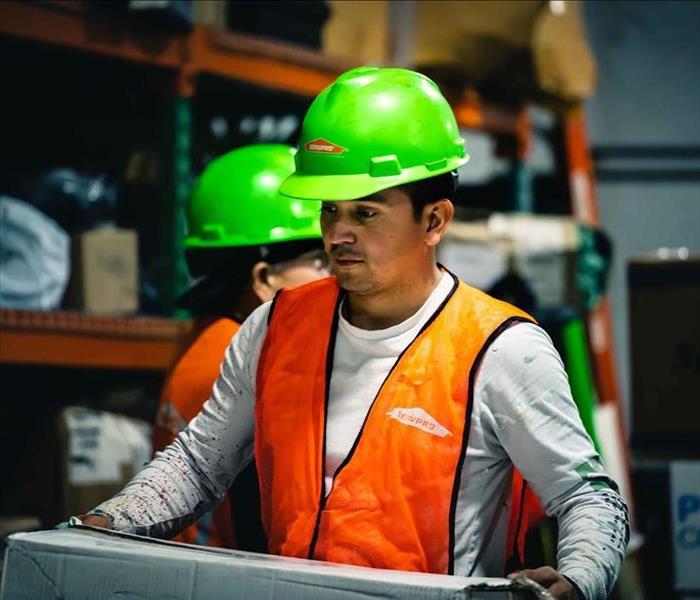 Our SERVPRO team is committed to providing best-in-class fire damage cleanup and soot removal services throughout North Atlanta, Chamblee and more.
Our SERVPRO team is committed to providing best-in-class fire damage cleanup and soot removal services throughout North Atlanta, Chamblee and more.
Fire damage can be devastating, leaving homeowners and business owners with the daunting task of restoring their property to its pre-fire condition. Fortunately, advances in technology have significantly improved the fire damage restoration process, making it more efficient and effective. In this blog post, we'll discuss the cutting-edge equipment used by professional restoration companies, such as SERVPRO of NW Dekalb/Dunwoody/Brookhaven, and how these tools have revolutionized the fire damage restoration process. Trust the experts at SERVPRO to provide the best fire damage restoration services, utilizing state-of-the-art equipment and techniques to restore your property quickly and efficiently.
Extraction and Drying Equipment for Water Removal
Water damage is often a byproduct of firefighting efforts, which can lead to additional problems such as mold growth and structural damage if not addressed promptly. Advanced extraction and drying equipment play a critical role in the fire damage restoration process by quickly removing excess water and moisture from the affected area.
- Portable and truck-mounted extractors: These powerful machines remove standing water and excess moisture from carpets, upholstery, and other porous materials.
- Dehumidifiers: By reducing humidity levels, dehumidifiers help to prevent mold growth and expedite the drying process.
- Air movers: These devices create high-velocity airflow, promoting evaporation and speeding up the drying process.
Soot and Smoke Removal Technologies
Soot and smoke residues can cause long-lasting damage to surfaces and belongings if not removed promptly and thoroughly. Modern technologies have significantly improved the efficiency and effectiveness of soot and smoke removal during the fire damage restoration process.
- Dry ice blasting: This environmentally friendly method uses solid CO2 pellets to remove soot, smoke, and other contaminants from surfaces without causing additional damage.
- Soot vacuums: Equipped with HEPA filters, these specialized vacuums effectively capture and remove soot particles, preventing them from spreading throughout the property.
- Air scrubbers: These devices use HEPA filters to capture airborne particles, including soot and smoke, and release clean, purified air back into the environment.
Odor Elimination Techniques
Removing lingering smoke odors is a crucial part of the fire damage restoration process. Advanced odor elimination technologies ensure that your property is free from unpleasant smells and ready for occupancy.
- Ozone generators: By producing ozone gas, these machines effectively neutralize smoke odors and other contaminants in the air and on surfaces.
- Hydroxyl generators: These devices use UV light to create hydroxyl radicals, which neutralize odors and contaminants without producing harmful byproducts.
- Thermal fogging: This technique uses a heated fogging machine to disperse a deodorizing solution, which penetrates porous materials and neutralizes smoke odors at the source.
Advanced Structural Drying and Repair Tools
Once water has been removed, and soot and smoke residues have been cleaned, advanced structural drying and repair tools help restore the property to its pre-fire condition.
- Infrared cameras: These devices enable technicians to identify hidden moisture within walls, floors, and ceilings, ensuring that all affected areas are properly dried.
- Moisture meters: By measuring the moisture content of various materials, technicians can accurately determine when the drying process is complete and prevent potential secondary damage.
- Structural repair equipment: Specialized tools, such as airless paint sprayers and thermal imaging cameras, help restoration professionals quickly and effectively repair fire-damaged structural components.
Conclusion
The fire damage restoration process has come a long way, thanks to advancements in technology and state-of-the-art equipment. By utilizing cutting-edge tools and techniques, professional restoration companies like SERVPRO of NW Dekalb/Dunwoody/Brookhaven can quickly and efficiently restore your property to its pre-fire condition, minimizing downtime and disruption. Don't let fire damage restoration become an additional burden during this challenging time. Reach out to SERVPRO of NW Dekalb/Dunwoody/Brookhaven at (770) 396-3883 to discuss your needs and let our skilled professionals take care of the rest. We're here to help you every step of the way, providing the support and expertise you need to restore your home or business to its former glory. Call us today and let us show you why we're the right choice for all your fire damage restoration needs.
Tips to Stay Safe during Fire Damage: SERVPRO of NW Dekalb/Dunwoody/Brookhaven
3/29/2022 (Permalink)
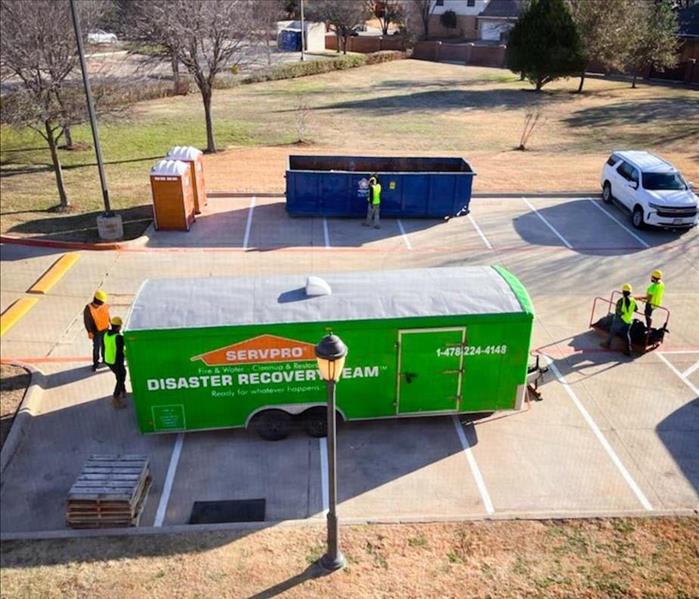 No matter how serious your property damage may be, SERVPRO of NW Dekalb/Dunwoody/Brookhaven is your local expert for restoring your home or business.
No matter how serious your property damage may be, SERVPRO of NW Dekalb/Dunwoody/Brookhaven is your local expert for restoring your home or business.
It's that time of year again - fire season in Dekalb County, GA, and surrounding areas. Between February and May, the weather gets hotter and drier, while the risk of house fires rises. A fire may start from a variety of sources, ranging from a faulty wire to an overloaded outlet to a kitchen mishap to a bonfire left unattended. It's critical to know how to react quickly and effectively if your home catches fire.
Here's What You Need To Know If A Fire Starts:
The first line of defense against a house fire is to know how to use the proper fire extinguisher for the situation. This simple procedure can help save lives and hundreds of thousands of dollars in property damage. If the fire spreads uncontrollably, evacuate immediately and stay away, then call 9-1-1. Leave all of your belongings where they are and save yourself and your loved ones.
If your clothing ignites, remember the old adage: Stop, Drop, and Roll.
It's critical to utilize the stairs if you live in a building with elevators in case of a fire. The elevator electrical system may be damaged by a fire, causing the shaft to operate like a chimney and rapidly fill up with deadly fumes.
Doors may be used to your advantage in a fire, potentially saving your life. If the doorknob or handle is hot, don't open it. If you can't exit through the primary route, look for another option. Do not open any doors that are warm to the touch.
Close any doors that might obstruct your exits, lay a wet towel beneath the doors, and call the fire department or 9-1-1 if flames, heat, or fire block your avenues of escape. Tell them exactly where you are so they can find you.
If you're near a window that you can't use as an escape, open it and wave a brightly colored cloth or use your phone flashlight to signal for help.
What To Do After a Fire
After a fire, it is important to contact a professional fire damage restoration company like SERVPRO of NW Dekalb/Dunwoody/Brookhaven. We have the training, experience, and equipment to properly restore your home - "Like it never even happened."
If you try to clean up the fire damage yourself, you could end up making the situation worse both in your home and with your insurance company's process.
Trust the experts, and call today!
4 Fire Safety Tips for Pet Owners
2/14/2022 (Permalink)
 Pet safety is important, remember to include your furry friend in your fire escape plan.
Pet safety is important, remember to include your furry friend in your fire escape plan.
How To Keep Your Pet Safe During a Fire
When you have pets, they become part of the family. Because they are so important to you, their safety is a top priority. Here are some tips for keeping your furry companions safe in case of a fire emergency in your Doraville, GA home.
1. Have an Escape Plan
While it is something that you hope you won’t need, it is important that you have an escape plan in case of a fire. You should include all family members in this plan so that everyone knows how to leave the home safely. Be sure to practice removing the animals from your home as well. Including pet preparation in your plan can help things go more smoothly during an emergency.
2. Know Your Pet’s Favorite Spot
A fire can be scary not only for you but for your pet as well. If your pet becomes alarmed or afraid, it may seek out a place where it feels comfortable. If this place is small and out of the way, it can make it difficult to locate your pet during a fire emergency. If you notice that your pet tends to spend a lot of time in a certain area, making a note of it can help you find your pet more quickly during a crisis.
3. Keep Your Pets Secure
Pet safety is important once you’ve removed them from the house as well. If you have a leash or a pet carrier, keep it in a convenient and easily-accessible location so that you can grab it quickly while leaving the house. If your pet is panicking, it may decide to run once outside and you may not be able to locate it after the situation has settled.
4. Keep Important Documents in a Fireproof Box
While this might not be an immediate concern during an emergency, it is a good idea to keep ownership papers and records in a fireproof box so that they can be easily recovered during fire remediation.
Including your pets in your fire emergency preparations can ensure that everyone makes it out of your home safely.
3 Things To Know About Using a Fire Extinguisher
1/21/2022 (Permalink)
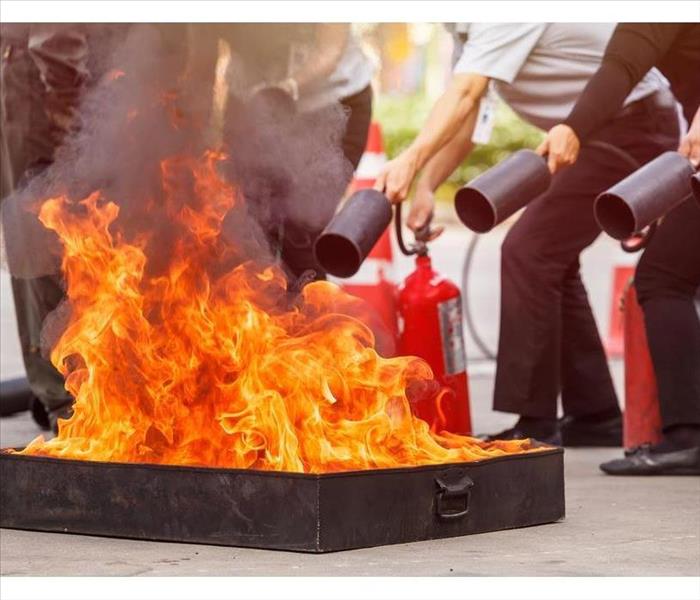 A fire contained in a trashcan could be extinguished quickly by an employee.
A fire contained in a trashcan could be extinguished quickly by an employee.
Three Things to Keep in Mind When Using a Fire Extinguisher
No matter the size, fires are dangerous. Employees need to evacuate a building if a fire is out of control. However, if a fire at your building in Dekalb, GA, is small and contained to one area, it is possible to eliminate the flames on your own using a fire extinguisher.
1. Know Your Equipment Before Disaster Strikes
While the steps required to use an extinguisher aren't exceptionally complicated under normal circumstances, things can change when a fire starts. The best way to prevent damage as a result of a small fire is to be acquainted with the extinguisher before you ever need to use it. This means yearly training on how to operate it. The more familiar an employee is with this device, the easier it will be to use when the time comes.
2. Assess the Fire Before You Act
A commercial building fire can cause fear and panic, but it's important to remain calm. The first thing to do during a fire is to activate the fire alarm. If a fire is large or out of control, employees should follow the building's evacuation plan and leave intervention to the fire department. If the fire is small, however, it might be possible to use a fire extinguisher to eliminate it. For example, it's possible that a kitchen fire on a stove or a fire contained in a trashcan could be extinguished quickly by an employee.
3. Use the Extinguisher Correctly
When using an extinguisher, here are a few things to keep in mind — although you should always read and follow your specific device's instructions.
- Pull the pin on the extinguisher; this will break the tamper seal.
- Always aim low and point the nozzle at the base of the fire.
- Squeeze the handle to release the firefighting agent.
- Step from side to side while using the extinguisher. Continue this motion until the fire is extinguished.
Repeat the last three steps with the fire extinguisher until the flames are out. If there is any doubt that you have not successfully snuffed the fire, evacuate immediately. Leave the firefighting to the professionals and the fire damage assessment to restoration experts.
What To Know About Dryer Lint
12/6/2021 (Permalink)
 Lint removal in order to avoid a dryer fire necessitates cleaning many areas.
Lint removal in order to avoid a dryer fire necessitates cleaning many areas.
Lint Removal From Your Dryer
To help avoid a lint fire in your Perimeter Center, GA, home, many professionals recommend regular maintenance of your dryer. Fortunately, there are many maintenance steps you can perform yourself. During this process, there are several things you may want to consider about lint removal from your dryer.
Where To Clean
Removing lint in order to avoid a dryer fire involves cleaning several locations.
- The lint screen
- The screen vent
- The exterior vent
- The exhaust hose
- The dryer back
- Behind the back panel
If you’re going to do more than wipe off the lint screen, it’s important to unplug your dryer first.
When To Clean
Many experts recommend deep cleaning your dryer at least once a year in order to avoid the build-up that can lead to a lint fire. If your dryer seems unusually hot during use, or if your clothes regularly fail to dry fully, you may want to perform a clean then as well. If problems persist then it’s recommended to contact a professional. It’s also recommended to clear the lint screen after every use.
Why Clean
Every year fire damage restoration services conduct repairs to homes that experience a fire due to lint built up. When lint accumulates inside the dryer it can cause the appliance to overheat. This is turn can lead to a fire made worse by lint’s flammable nature. Keeping your dryer clean is one way to help avoid this type of fire in your home.
Regularly removing lint from your dryer can help prevent a lint fire in your home. You could consider cleaning all the areas of your dryer including the exhaust hose and exterior vent. The dryer should be cleaned at least once a year, and lint from the screen should be removed after each use. If you think your machine is malfunctioning it’s best to call in a professional.
What Sets Smart Smoke Detectors Apart?
11/10/2021 (Permalink)
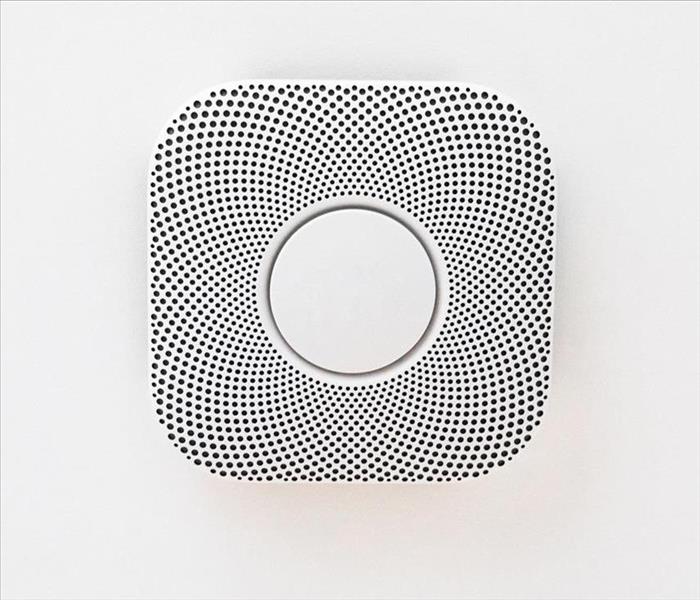 Smart smoke detectors are a relatively new technology.
Smart smoke detectors are a relatively new technology.
Smart smoke detectors are a relatively new technology that can send push notifications to smartphones and may be controlled remotely. Find out how a next-generation smoke alarm can protect your home.
Smart Alarms Types
There are three types of smart fire safety devices:
- Smart batteries
- Smart detectors
- Listeners
Smart batteries can be used in standard battery-powered smoke detectors or as backups in hardwired units. Smart detectors may cover more square-footage than standard alarms and can be controlled remotely. Listeners send alerts when any alarm is triggered.
Technological Differences
A smart battery is an affordable way to monitor your home while you are out. This technology functions like a nine-volt battery but has Wi-Fi connectivity to send notifications. You can silence battery-powered alarms remotely, but this function does not work for hardwired alarms with smart battery backups.
A smart smoke alarm also sends notifications, can be remotely controlled and may be capable of monitoring more than one floor of your home. Some devices alert users to elevated carbon monoxide levels. Listeners send notifications whenever an alarm sounds in your home, though these devices are not capable of silencing alarms.
Smart Alarms Effectiveness
A single smart alarm may monitor an entire floor of your home, or more. If your home is spacious, you may want to just install a listener to notify you of any alarms.
Smart Detector Costs
Smart fire safety solutions are available in a wide price range:
• The initial smart battery unit retails for about $35 with $15 replacements once or twice a year
• Smart detectors start around $100
• Listeners range from $50 to $100
Consider a smart smoke alarm or smoke detector device to receive timely push notifications about alarms. All of these devices can increase overall safety at your residence in Perimeter Center, GA. If a fire results in damage, rely on the expertise of damage restoration professionals.
The ABCs of Home Fire Extinguishers
7/23/2021 (Permalink)
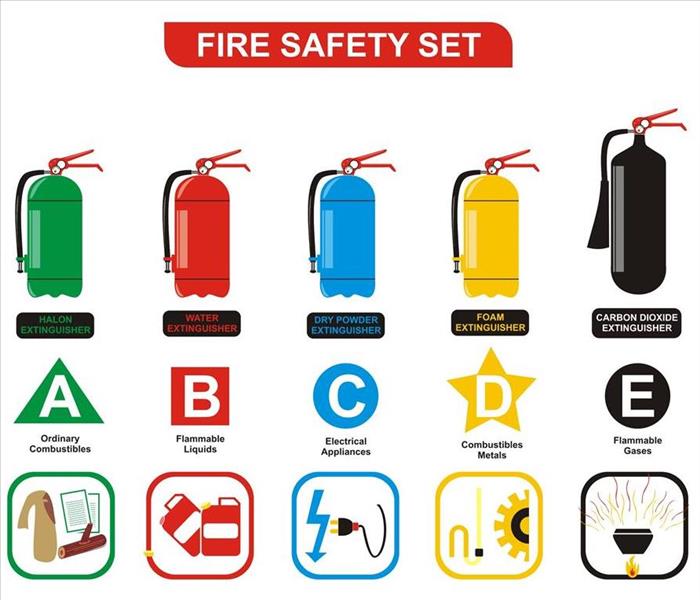 Most household extinguishers can put out a home fire and electrical fire at the same time.
Most household extinguishers can put out a home fire and electrical fire at the same time.
The ABCs Of Fire Extinguishers At Home
The unique shape, markings, and color of the fire extinguisher have long been established and accepted. Therefore, when standing near a small fire, everyone knows to look for the long, red cylinder to use for fire suppression. What most people do not know is that there are different types of classifications of household fire suppressors, and once purchased, the chemicals inside are not good forever.
Classifications
The fire extinguisher has been around for over 150 years. Originally designed to put out combustible fires with potassium carbonate, as times changed and fires evolved, so did the fire suppressors. The units now come in three types:
Class A is for use on ordinary household combustibles.
Class B can be used on flammable gas or liquid.
Class C units are designed for use on electrical fires.
Although the specially designed fire containment containers used to be manufactured with only one of the various class of chemicals, the new and modern versions often contain all three. For that reason, most household extinguishers can put out a home fire and electrical fire at the same time.
Longevity
Fire repair and restoration teams stress the importance of understanding that fire extinguishers are not meant to last forever. Depending on the brand you buy, the manufacturers typically state that most expiration dates fall somewhere between five and fifteen years from purchase date. If the label does not have a date, or there is no inspection tag attached to the unit, look at the pressure gauge and recharge as soon as the needle falls below the green area.
Safety
Your home in Chamblee,GA may be your castle, but if you do not have a fire preparedness plan in place, that castle could quickly burn down. Keep your fire extinguisher handy, do not store it away in inaccessible areas. It only takes a few moments for a fire to overwhelm a room, but if you have the suppressor close at hand, you can be on top of the fire and not let it grow out of control.
Dry It, Don’t Fry It: Tips for Reducing the Chances of a Dryer Fire in Your Home
6/28/2021 (Permalink)
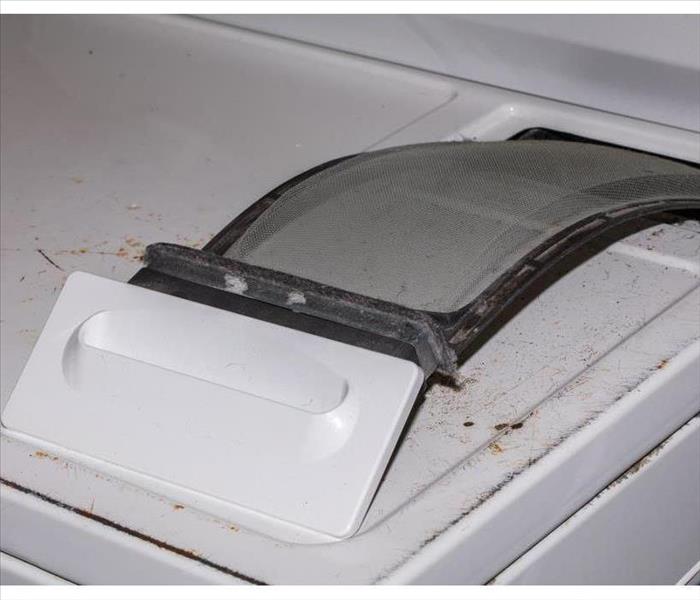 Your dryer should help you, not hinder you with fire.
Your dryer should help you, not hinder you with fire.
How Can You Prevent A Dryer Fire?
Like dozens of other appliances and hardware in your home, your dryer was designed to make life more convenient. It allows you to get done with your chores faster so you can spend more time with friends, family, and simply doing what you love to do in North Atlanta, GA. However, they’re also one of the leading causes of house fires in the United States. The average lint fire has caused
- Nearly 2,900 emergency calls each year
- 5 deaths and 100 injuries annually
- $35 million in property damage in the span of a year
Luckily for you, there are plenty of things you can do as a homeowner to prevent one of these common fires from starting in your home.
Dry Smaller Loads
When you overload your dryer, it leads to a wide number of issues. An overloaded dryer contains more clothes for a blaze to feed on in the early stages. Drying smaller loads is not only more efficient in the long run, but it’s safer and takes a little extra time and effort from you.
Clean and Maintain Your Lint Trap
An overloaded or otherwise problematic lint trap is the leading cause of dryer fires. The dust, hair, and threads that make up the material in the lint trap are extremely flammable. If the buildup becomes too much, the high heat of the dryer itself can set it ablaze. Therefore, empty out your lint trap between every load to avoid a lint fire.
Be Aware of What You’re Drying
Unfortunately, not everything can go in the dryer. The high heat settings can burn, melt other otherwise destroy items that contain foam, rubber, or plastic. Rather than using the appliance, set these items outdoors or in another open space to dry. It’s just as effective and reduces the chances of accidentally starting a dryer fire.
Your dryer should help you, not hinder you with fire. Following these simple tips takes only minutes during your regular laundry routine and can drastically reduce the chances of a lint fire happening in your home.
What Is a Board Up Service and Do I Need One?
3/30/2021 (Permalink)
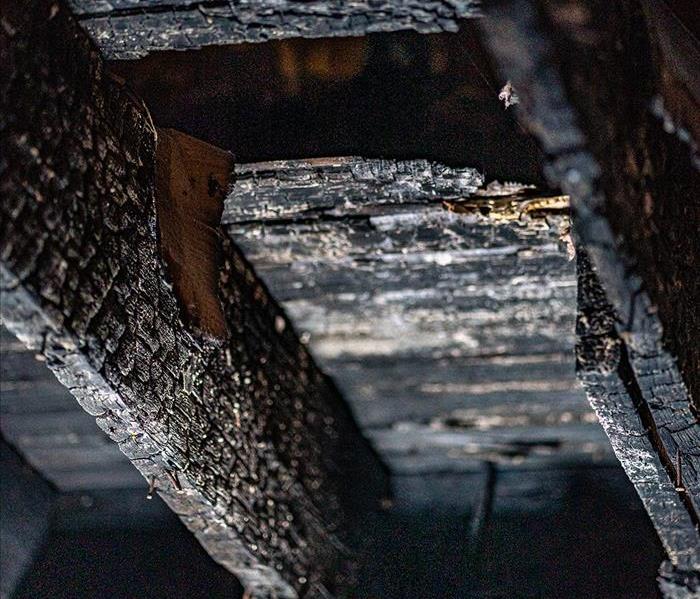 Severe fire damage in Brookhaven, GA.
Severe fire damage in Brookhaven, GA.
What Does Board Up Services Mean
When your home has sustained fire damage in Brookhaven, GA, your first priority is to get your family settled in a safe place, not worry about your damaged home since it will be a while until everything can be repaired. Despite the challenges you're likely facing as you recover from this disaster, properly securing your home is important. One of the first things that will be recommended by a fire damage restoration company is an emergency board up service. This service is an important part of your home restoration for several reasons.
1. Insurance
Most likely, your insurance company will require that your home is properly sealed in between the occurrence of the damage and when the repairs are done. Insurance pays for what is originally quoted, and if more damage is done, you'll have to pay more.
2. Liability
If your home isn't properly secured by a board up service, anyone who enters your home and gets injured could press charges.
3. Damage
Further damage from weather, animals, or humans makes an already difficult situation worse. Securing your home prevents most of the additional damage.
4. Property Loss
An open home is an open invitation to people who want what you have. While you may think there isn't much left, anything from appliances to pipes to your HVAC system can be stolen for profit, leaving you to foot the bill.
5. Professionalism
When you trust a company to do the board up service for you, you can be confident that it will be done correctly. DIY may sound simple, but in addition to being a two-person job, you can cause more damage by improperly placing boards or your efforts simply aren't effective because you're not using the right materials.
Securing your home with a board up service after a fire is not only recommended by most insurance companies, but you can have peace of mind knowing that your home will be protected until the restoration is complete.
How Do Experts Restore Fire Damage?
2/2/2021 (Permalink)
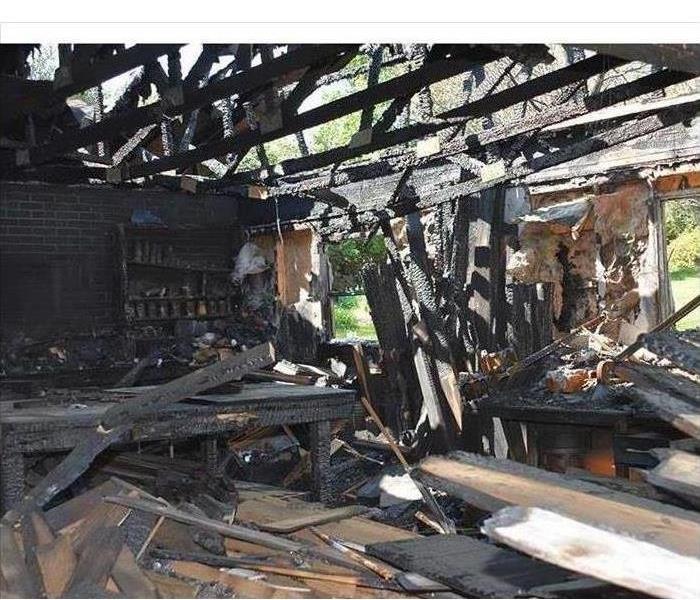 Fire damage in Brookhaven, GA
Fire damage in Brookhaven, GA
Four Stages of Fire Restoration
A home that has recently sustained damage from a fire should be cleaned and restored by certified professionals. This process starts with damage cleaning and continues through rebuilding to the finishing touches. Learn more about the four stages of fire restoration.
1. Inspect
Experts will examine the location of a fire to determine which building materials and contents need to be cleaned or replaced. This assessment will also identify the mitigation measures that should be taken and the scope of restoration. An all-in-one company can provide a verbal briefing within hours after inspecting damage followed by a single estimate that accounts for mitigation and restoration.
2. Mitigate
Mitigation should begin as soon as fire damage specialists have a clear idea of the extent of damage and homeowners have photographic or video evidence to provide to an insurer. The primary goal of this phase of the process is to prevent damage from getting worse prior to cleaning and restoration. Mitigation may involve boarding up broken windows or structural breaches, tarping over holes in the roof or putting up security fencing.
3. Clean
Cleaning is a critical step toward fire restoration. Professionals use commercial-grade equipment to remove soot and any standing water remaining after fire suppression. After eliminating water and debris, experts may tear out damaged building materials or wipe down stained surfaces. Restoration can proceed after cleanup is complete.
4. Restore
Restoring a fire-damaged residence can range from cleaning and replacing a few components all the way to a full rebuild. This process may take days or weeks, depending on the extent and severity of the damage. Finishing touches may include cleaning smoke damage and odor mitigation.
Homeowners should rely on a one-stop shop that provides all of these services with a single estimate and schedule. Insurance companies prefer to work with an IICRC-certified fire restoration company located in Brookhaven, GA.
3 Possessions You Might Have To Trash After a Fire
12/8/2020 (Permalink)
 Medicines are also susceptible to high heat, smoke, and fire
Medicines are also susceptible to high heat, smoke, and fire
Items You Have To Throw Away
According to the National Fire Protection Association, or NFPA, in 2019 out of all the fires reported 27% were home fires. Fires can wreak havoc on structures, completely gutting them. They also often result in high heat, smoke and fire damage to the contents of homes. However, not all fires result in complete and utter devastation with little left to salvage. Sometimes there is a great deal that can be saved with the aid of a professional cleanup and restoration service in Dunwoody, GA. However, there are certain items you are likely to have to throw away.
1. Fabrics
Sheets, blankets, and clothing are often recoverable in the wake of a fire. Proper disinfection and cleaning can usually restore fabrics and textiles for use. However, this generally only applies to non-burnt items. Clothes or bedding that have been burned should be thrown away.
2. Food
You might have to throw away food, both perishables, and non-perishables. Some foodstuffs like those in open containers or charred cardboard boxes are obviously on the disposal list. However, even supplies sealed in cans or jars may have been rendered inedible by the presence of bacteria whose growth was spurred on by high heat. Refrigerated and frozen food occasionally survives in good condition, but if you notice any of the following signs, it is best to discard the contents of your fridge or freezer:
- Soot in the fridge
- A strange smell coming from food
- A smoky odor in the fridge
- Freezer food is soft without visible ice crystals
3. Makeup and Medicine
Cosmetics and medicines are also susceptible to high heat, smoke, and fire. Any sign of damage, like charring, warping, or fire extinguisher remains are indicators that you need to get rid of products in these categories. They are no longer usable.
While not all possessions in the aftermath of fire are ruined, the ones listed here are commonly beyond saving. If you observe any of the signs listed here, you should throw away the things displaying them.
What To Know About Partial Fire Losses
11/11/2020 (Permalink)
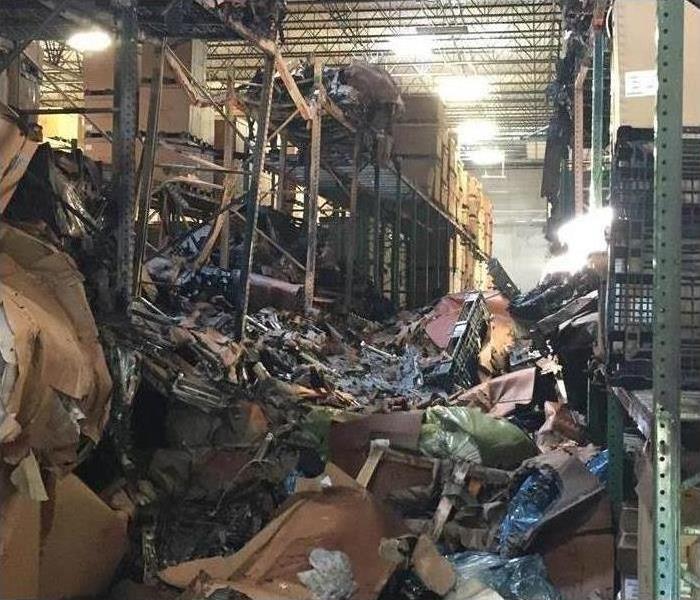 Partial fire loss in Brookhaven, GA
Partial fire loss in Brookhaven, GA
Ways To Handle Fire Damage
Not every fire completely destroys a property. You could instead end up with a partial fire loss. Here are some tips for handling this type of loss.
Inspections
Even if you only suffered a partial loss to your commercial property, you should hire structural engineers or contractors to survey the building and estimate the costs of repairs. Do not rely on the insurance adjuster's inspection alone. Choose a specialist who will survey each of these areas:
- Windows
- Structural iron and steel
- Heating and plumbing systems
- Roof
- Interior walls
- Siding, concrete and stucco
Smoke Cleanup
A partial loss often includes ash and smoke damage. Smoke can harm porous items, including curtains and rugs. It can also discolor tiles and marble.
Fire restoration professionals in Brookhaven, GA, should be able to repair some of these items. You may have to replace other things, however. Either way, your insurance may help you pay for the fire loss.
The insurance adjuster may tell you that a deep cleaning is not necessary. However, this is just the insurance company's way of trying to save money. Insist on a thorough remediation.
Mold Cleanup
The water used to suppress the fire can cause mold growth inside wood and drywall. Get the property inspected right away to see if you have a mold problem. You should also check your insurance policy to find out if it has a mold exclusion.
Landscape Cleanup
Insurance does not just apply to the inside of your commercial property. The smoke and heat may contaminate soil and kill your outdoor plants. Harmed plants may not die right away, so keep your insurance claim open for a few months after the fire.
A partial fire loss can include smoke and soot damage. Your landscaping could be harmed, as well. Thankfully, you can use your insurance to pay for some of these repairs. The above tips should help you get your property back to normal as soon as possible.
What Can and Can’t Be Salvaged After a Fire?
9/18/2020 (Permalink)
 Canned food needs to be toss right away
Canned food needs to be toss right away
Even a small fire in your Doraville, GA, can be devastating and overwhelming. Along with sorting through charred items that you will have to throw away, it can be confusing as to what is and isn’t salvageable. When it comes to high heat, it can severely damage items without them visibly looking damaged.
5 Items to Toss
From burning, melting plastic to stains and smoke damage, some materials aren’t able to withstand the heat and aftereffects of flames. Throw away the following items if they have been in close contact with smoke, flames, soot, or heat.
Non-Perishable Foods – This includes canned, boxed, and shelf-stable goods. If the package has been opened, it is especially important to toss it.
Perishable Foods – Any foods left at room temperature, such as fruits, will need to be discarded. If the heat was constantly high for more than two hours, items in the refrigerator and freezer may also have to be thrown away.
Medicines and Cosmetic – These items often have chemicals or minerals of them that could be affected by extreme heat, resulting in a change of composition.
Burned Fabrics – Clothing, bedding, curtains, and other fabrics with visible fire damage and stains shouldn’t be kept. If there is minimal staining, a professional fire restoration specialist may have the tools to restore your belongings.
Damaged Mattresses and Furniture – Although wood furniture may be salvageable if there are only stains, flames from a fire can degrade their structural soundness.
Salvageable Items
As you look at the damage, it may seem like nothing can be saved. Luckily, with the right help, you may be able to salvage more than you thought. Nonporous surfaces are the easiest to rescue, such as glass and metal, and may only require thorough cleaning and deodorizing. Hardwood floors that have barely been affected can also be restored.
While the first thought may be to throw away everything in sight after a fire, take a moment to inspect the damage. Although the items above should never be saved, you may not have to face a total loss.
How To Prepare Your Business for a Fire
7/9/2020 (Permalink)
 Create a contingency plan for your business
Create a contingency plan for your business
How To Prepare Your Business for a Fire
As a business owner, there are many things you can do to prepare your building and employees for emergencies. Your efforts toward creating and maintaining a safe workplace should include writing a contingency plan. There are five steps, outlined by the Department of Homeland Security, that are involved in putting together a plan of action:
- Program management
- Planning
- Implementation
- Testing and exercises
- Program improvement
Take a look at how preparing your business for a fire-related emergency might look.
Program Management
The success of your preparedness plan depends on the commitment of management. This means you need to commit to spending time and some money on creating the plan and providing appropriate resources. This step also involves researching regulations in your area that outline the minimum requirements for workplace fire safety.
Planning
At this stage of creating your fire contingency plan, you should gather as much information about fire hazards and risks as you can. Your insurance provider may be an excellent resource. You could also reach out to fire damage cleanup and restoration professionals for another perspective. Complete a business impact analysis and look at methods of reducing fire hazards.
Implementation
At this point in putting together your preparedness plan, you should have written explanations for resource management, emergency response actions, emergency communication protocols, employee responsibilities, incident management steps, and scheduled trainings.
Testing and Exercises
Train your employees in the steps of your plan. Clarify the roles and responsibilities of individuals and run drills to support employees' abilities to follow your evacuation plan. During this step, watch out for any weaknesses in your plan and reach out to the Mount Vernon, GA, fire department for advice about making improvements.
Program Improvement
During this final step, schedule reviews of the plan to keep it up to date, look for ways to evaluate the effectiveness of the plan, and use your reviews and information from tests and exercises to improve the plan.
Putting together a contingency plan for the hazards your business may face should focus on keeping your employees and your physical properties safe. Start today and reach out to available resources in Mount Vernon, GA.
 Our SERVPRO team is committed to providing best-in-class fire damage cleanup and soot removal services throughout North Atlanta, Chamblee and more.
Our SERVPRO team is committed to providing best-in-class fire damage cleanup and soot removal services throughout North Atlanta, Chamblee and more.





 24/7 Emergency Service
24/7 Emergency Service











